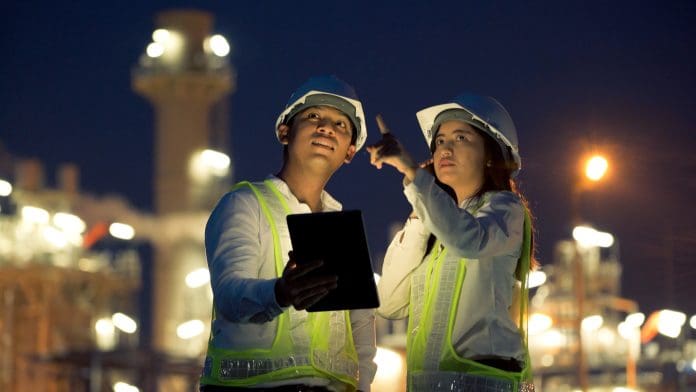Following the rapid internationalisation of the Norwegian construction AI scale-up Imerso, the company explains the growing trend of automation and digitisation in closing the gap between the office and the site
BIM is undeniably cementing its role within construction’s planning and design domains. Nonetheless, the persistent dissonance between the meticulously outlined BIM plans and the harsh practicalities of the job site remains a recurring obstacle.
Large investments thrown into a project’s early design and planning stages make little difference.
The gap between the map and the terrain in the execution phase invariably leads to unnecessary rework and delay costs, and a litany of quality issues.
Teams can no longer afford to track their projects with Post-it notes, checklists, photos and manual inspection visits. We need measurements; we need better information; we need answers.
A powerful solution is emerging in the form of automatic workflows that track the onsite work status against the BIM plans throughout the construction process.
This requires a modern alchemy that combines advanced technologies to bridge the gap between reality and digital blueprints: artificial intelligence, laser scanning and the eye of big data analytics. United, these innovations are weaving real-time data from the job site into the digital fabric of the BIM models.
This is a construction manager’s dream: team leaders empowered with unparalleled answers from a tireless digital assistant that meticulously oversees work quality and progress, swiftly detecting problematic deviations early and eliminating costly risks before they happen.
A variety of outdated manual processes can be augmented by this. The laborious site monitoring and quality control measures that have historically required weeks of onsite work even for minor job site sections can now be delivered in a matter of minutes spanning the entire construction site.
Rather than sporadic status updates, a feedback loop between the site and the office can now be achieved on a weekly or daily basis. And most importantly, all project partners can benefit from the levelling of the playing field in terms of access to job site information to better deliver their respective tasks.
Thus, a new epoch dawns, redefining the landscape of lean construction.
Enter the age of AI-based construction management and automatic monitoring of as-built vs BIM.
What’s driving this trend?
Multiple factors are coalescing to propel the ascent of automatic quality control and site monitoring within the realm of construction management:
1. Owner sophistication keeps increasing
Construction projects are growing in size and complexity, alongside project owner’s requirements and closer involvement in the construction phase. A much wider range of projects are now requiring the use of BIM, more detailed reporting and final deliverables, integration of prefabrication and offsite construction elements, along with sophisticated risk-reward models aimed at aligning incentives across participants.
While lack of accessible information remains a major challenge in construction, these factors are creating a pull for solutions able to level the playing field, mitigate blindspots about the factual onsite reality and drive new cooperation dynamics that benefit the project as a whole.
2. Availability of high-precision, high-fidelity data
The integration of precise data capturing through frequent laser scanning routines, together with objective automated analytics, is doing wonders at removing uncertainty and guesswork in the naturally chaotic and ever-changing landscape of a construction environment.
Millimetre-accurate measurements of the as-built environment are captured onsite in a matter of minutes, resulting in meticulous work documentation. Direct analytics against the planned design intent in BIM leads to a reduction in the likelihood of inadvertently overlooking problematic deviations.
Large amounts of volumetric data are automatically scrutinised, flagging work errors and issues that escape human observation, no matter how many photos are taken. This not only vastly expands the control area but also delivers objective and detailed information that is shared across teams.
Everyone sees the same thing and has all the information needed to start resolving the problem immediately. Need a measurement? Simply log in to the digital jobsite from any browser and get your answers.
3. Streamlined collaboration and fast feedback loops
This trend aligns exquisitely with the tenets of lean construction, which underscore the minimisation of waste, continuous improvement and heightened efficiency. As projects move towards collaboration driven contract models, participants are moving away from the typical self-concern attitude and into a more transparent, project-success orientation.
In lean construction, there is only “we”; you cannot improve what you don’t measure; and waste – in any form – is disrespectful to everyone involved. These factors are pushing to close the gap in information across project partners, along with the gap between the site and the office.
With lean methods like Takt Planning or the Last Planner Method measuring work pace on a weekly or even daily basis, the need for routine status feedback keeps growing, driving the team’s ability to keep track of what’s going on and proactively solve problems as soon as they arise.
What do AI-based construction companies gain?
Faster and better jobsite documentation
“We can keep the models accurate to what is built. We can hand over building documentation continuously instead of at the very end. That saves us a lot of time,” says the head of innovation at Betonmast, one of Norway’s largest general contractors.
Higher margins in construction projects
Region Hovestaden, in its iconic NHN hospital project, saved costs worth a remarkable 2% of its construction budget using Imerso to mitigate project risks and maintain tighter control over the work quality.
Faster issue resolutions
Norconsult, Nordic’s leading architectural community, decreased issue-resolution time from 45 to 2 days at one of its recent projects.
Charmaine Menardo
Imerso AS
+47 4652 3824
*Please note that this is a commercial profile.

















